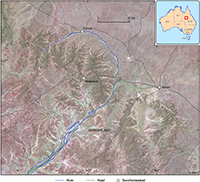News
Potential asteroid impact identified in western Queensland
Published:17 March 2015
Researchers have identified a roughly circular structure west of Winton in western Queensland that may have been created by an asteroid impact around 300 million years ago.
Large impact structures are scientifically important as they provide potential clues to the evolution of the Earth's crust. They can also have economic significance due to their potential for hosting mineral and petroleum resources.
Evidence is growing for a high rate of large asteroid impacts throughout the evolution of the Earth. To date around 32 confirmed impact craters and structures have been identified on the Australian continent and surrounding continental shelf. The new structure being studied in Queensland shows similar characteristics to a number of previously confirmed impact structures.
Large, buried asteroid impact structures can be found using a number of geophysical methods in combination with structural geology information, commonly obtained from drill core samples.
In this work led by Geoscience Australia visiting scientist Dr Andrew Glikson the 130 kilometre diameter circular shape of the Diamantina River drainage pattern was the first indication of a possible impact. A circular anomaly was also defined in other geophysical data:
- Magnetic data reveals a circular magnetically quiet zone that is superimposed on linear magnetic trends. When a large impact event occurs it affects the magnetic field of the disturbed rocks, which results in the formation of magnetic ring structures.
- A deep seismic reflection line image that transects the perimeter of the circular structure shows dramatic differences between the structure and its surrounds. The possible inference being that a large impact has disturbed the structure of the deep crust within the circular zone.
- Gravity anomaly images also show a central anomaly representing the difference between the regional gravity field data and the density of rocks disturbed within the impact structure.
This information is consistent with the characteristic features of buried asteroid impact structures. This possibility could be confirmed by physical sampling from drill holes penetrating the basement layer in the central parts of the ring structure to a depth of many hundreds of metres.
Email:





